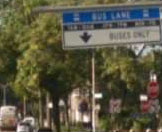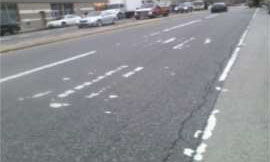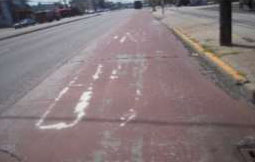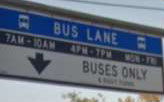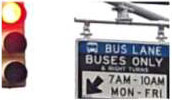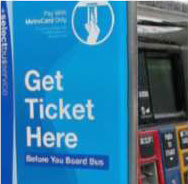A Closer Look at This Year’s Specialized High School Admissions

(Edwin J. Torres/Mayoral Photography Office)
Critics of the test used for admitting students to New York City’s specialized high schools -- Brooklyn Tech, Stuyvesant, Bronx Science, and five others -- failed to properly assess this year’s test and admission results because they yearned for a more robust increase in offers to black and Latino students, when compared to the year before. The city had improved the test and increased outreach and free test prep, all efforts intended to redress their underrepresentation, but in a school system where more than 70 percent of students are from black and Latino families, just 10 percent of the seats in the specialized high schools were offered to students from those communities.
This disparity is unacceptable. But so too is a failure to properly analyze the test and admission results, and thereby call the city’s efforts a total failure and demand simply that the test be eliminated in one way or the other. Such an approach overlooks what is and can be done to help remedy the city’s decades of neglect in many of the schools serving black and Latino communities.
While a sudden turnaround was not to be expected, this year’s test results did show that as a percentage of all offers, there was a small increase in offers made to black students. In absolute terms, 207 black students received offers compared to 194 the year before. On the other hand, Latino admissions declined by 10, to 320 from the latest test. Because both white and Asian offers of enrollment declined this year, both absolutely and as a percentage of total offers made, it could be argued that these results potentially show an inflection point for black admissions. However, since the students self-identifying as “multi-racial” nearly doubled, to 128, and because the race of 419 others is unknown, it would be premature to make such a claim.
Also ignored by critics of the test, was any appreciation of the city’s contradictory efforts.
On the one hand, it increased free test prep. On the other, it changed the test, making it harder to prepare. While the Brooklyn Tech Alumni Foundation, which I head, supported changing the test to make it better aligned with what is supposed to be taught in our schools, and thereby mitigate against a test prep advantage, we shouldn’t entirely ignore this issue in our discussion of the latest test’s results.
Notably, while 450 more Asian students took the test this year, fewer were admitted this year than last in both absolute and percentage terms. Because the accusation has frequently been made that the test’s results are skewed because so many Asian students do test prep, the city’s effort to mitigate test prep advantages may well have worked. Since the city is again changing the test to be administered later this year, by, for example, including poetry, a fair and proper assessment of the city’s efforts may take a few more years.
Other efforts can and should be made. One step the city could take is to revamp the Discovery Program – a long-standing, if unused, program which lets “disadvantaged” students who fall just short of the test’s cut-off score get a second chance for admission. By a targeted redefinition of what “disadvantaged” means, focusing on the underrepresented schools and communities, more high-performing black and Latino students will have increased chances for success.
Another effort that should be adopted is the bill in Albany sponsored by Bronx State Senator Jamaal Bailey, a Bronx Science graduate, that mandates administration of a free and voluntary practice SHSAT, the specialized high school test, to be offered in sixth grade, with students receiving an analysis of test results to identify areas in need of improvement before the test is given in eighth grade. We give a PSAT for obvious reasons, why not a PSHSAT?
Alumni from all eight test-in schools believe deeply in increasing diversity at their schools, but believe just as deeply in keeping the test as the single criterion for admissions as an objective measure immune to the kinds of influence many more affluent white families use to gain entry for their children to better schools that use the kind of subjective criteria that Mayor de Blasio and others have said should replace the test. For example, the student body of Brooklyn Tech, which sits in the middle of Brownstone Brooklyn, is 80 percent students of color.
The decades of declining enrollment in specialized high schools experienced by the black and Latino communities correlates with the elimination of enriched educational programs at many of the elementary and middle schools in these communities. Today only 15 middle schools account for over half of the students in the specialized high schools; none are in black or Latino communities. A fair assessment of the city’s efforts simply cannot ignore the impact of decades of neglect by the Board of Education and its successor, the Department of Education.
Ultimately, the city needs a plan to promote the creation of pipeline middle schools located within the black and Latino communities of our city. This requires the creation of vibrant gifted and talented programs in the elementary schools and enriched coursework in the middle schools. The new chancellor would be well-advised to create such a plan.
At the same time, efforts to increase outreach, free test prep, reconfiguring the Discovery Program to enroll more disadvantaged students from black and Latino communities, among other measures, can help to promote more diversity at Brooklyn Tech and the other test-in high schools. Such efforts should be fairly and accurately evaluated, not skipped over in a rush to demand elimination of the test.
***
Larry Cary is a Manhattan lawyer and president of the Brooklyn Tech Alumni Foundation.
***
Have an op-ed idea or submission for Gotham Gazette? Email This email address is being protected from spambots. You need JavaScript enabled to view it.
The Great Select Bus Service Conspiracy: Part II
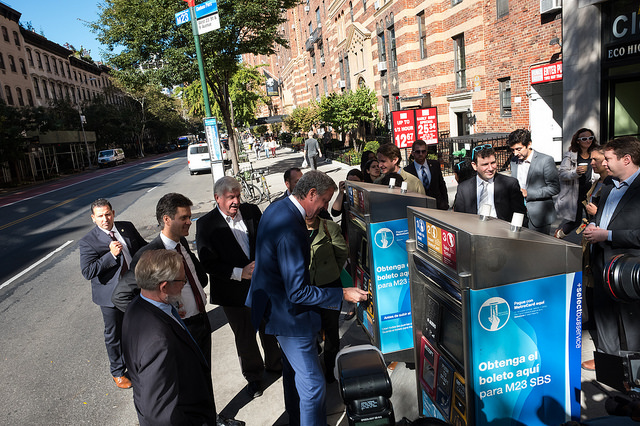
(photo: Edwin J. Torres/Mayor's Office)
This is part two of a three-part series
Denigration of Local Bus Service
In many cases, the introduction of SBS has resulted in a denigration of local bus service -- though this does not apply to Manhattan crosstown routes. Most notably this has occurred on the M15 First and Second Avenue routes in Manhattan and on the B44 and B46 routes in Brooklyn. Many riders who prefer the local are now forced to walk further to an SBS stop after waiting a half-hour for a local and seeing three SBS buses bypass their stop.
After implementation of the B44 SBS, complaints of long waits up to 45-minutes for the local forced the MTA to add additional local service, after three months and a new SBS stop at Avenue L. Although the B44 SBS uses the longer buses with a 50 percent greater capacity while the local uses standard length buses, local buses are more crowded since ridership is equally split between SBS and local. Riders complain of near empty SBS buses passing them by.
Problems with Enforcement
Passengers and cars are sometimes summonsed unfairly and a kangaroo court system exists where innocent people often are found guilty. Just a few examples: convicted for theft of services, a fine of $150, when it is proven at the hearing that there was a valid transfer on the MetroCard; cameras ticketing cars for crossing the bus lane when pulling out of or entering legal parking spaces; being summonsed during hours that a bus lane is not in effect, or a minute after it goes into effect or one minute before it is no longer in effect. Should someone be penalized with a fine exceeding $100 because his watch is a minute early or late? There should be a grace period of five minutes, as with muni-parking meters. And summonses mailed three months later make it difficult to mount a court defense.
There was at least one instance in 2014, captured on video, of police shoving, harassing and kicking a passenger for five minutes after getting off the bus, although he produces ID and an SBS receipt as requested. We do not know what interactions preceded the video but it appears from the video that the individual is doing nothing wrong.
There have been instances where bus operators have told passengers to board the bus because all fare machines at a bus stop were broken and to get off at the next stop to obtain a receipt. However, before they could comply, the Eagle Team boarded the bus and summonsed them. This would not leave a favorable opinion about New York City if it happened to a tourist. The MTA has since clarified its fare payment policy when all machines at a bus stop are inoperable.
|
|
|
|
|
|
|
|
|
|
|
|
Other SBS Problems
Fare machines on the first route (Bx12) had to be replaced after three years because no one thought of providing weather protection, wasting millions. There are many SBS problems that the city and MTA have not resolved. These are: worn out pavement markings; poor and confusing signage for motorists; broken countdown time clocks and fare machines sometimes not repaired for months; inadequate exclusive bus lane enforcement; and riders who need an additional bus transfer due to SBS and are therefore required to pay extra fares to utilize SBS. (The governor recently vetoed legislation permitting an extra bus transfer for a single fare.)
The picture of the Nostrand Avenue bus lane in Sheepshead Bay was taken a year after implementation in 2014. It still has not been repainted.
Drivers are supposed to know that right turns must be made from the bus lane even on blocks where a “Buses Only” sign is posted on the prior block, although there is no additional signage to indicate that. Actually, right turns must be made from the bus lane about 50 feet after the “Buses Only” sign (pictured). Where signs do indicate right turns
are allowed (pictured) the words “& Right Turns” are too small to be easily read at speeds over 20 MPH. They should be the same size as the words “Buses Only.”
Machines are not always placed where they are easily seen, making them easy to miss if you are running for a bus and are not aware beforehand that the route is SBS. Occasionally, non-SBS wrapped buses are used in SBS service which accept fares subjecting you to a summons if you board not realizing you are on an SBS bus. The signage at bus stops also could be clearer. The print stating "Get Ticket Here" and in much smaller print "Before You Board Bus" could be interpreted as paying before you board is an option. “Get Ticket Here” should be preceded with "YOU MUST" in large capital letters. To make matters worse, bus operators may not inform confused passengers who they see boarding without a receipt that one is necessary.
The 60-foot buses used on many SBS routes are more difficult to maneuver, do not work well in snow storms, have higher labor and fuel costs, and are more inefficient than 40-footers when the bus is lightly loaded. Yet the MTA does not substitute them with regular-length buses during times of light usage, such as during evening and overnight hours.
All SBS problems need to be addressed before the system is expanded further.
Negative Effects on Traffic and Local Businesses
There have also been negative effects on traffic caused by exclusive bus lanes that are being ignored or explained away. The Woodhaven Boulevard SBS has helped increase automobile travel times during peak hours by as much as 45 minutes. This is significant because about 80 percent of motor vehicle traffic is not bus riders and SBS is not attractive enough for people to switch to the bus. Bus lanes on Woodhaven Boulevard do not result in faster buses in the off-peak, but are mostly in effect 24/7 anyway. Curbside bus lanes on Saturdays were not necessary and have hurt businesses. The longer bus stops required for 60-foot buses reduce available parking.
DOT is proposing exclusive bus lanes on the wide portion of Kings Highway for the B82 where buses are already traveling near the 25 MPH speed limit except for three hours a day. This will also negatively affect traffic and will not benefit bus passengers. Merchants and elected officials are opposing bus lanes on the narrow portion of the road.
Public Participation is Inadequate
The “democratic process” used to create SBS routes is an illusion. There is no specific outreach to alert motorists; public meetings are not adequately publicized, and there have been complaints of some of them being held at inconvenient hours; SBS information for proposed routes and SBS progress reports are difficult to find on the internet; no public hearings (different from meetings) are held; many community concerns and negatives, such as reduced parking, are ignored; half-truths are presented with many omissions; DOT and the MTA only respond to questions they want to answer.
Community groups are allowed only one representative at Community Advisory Committee meetings. However, DOT stacked at least one of the 2015 Woodhaven Boulevard meetings with three supporters from Transportation Alternatives.
When actual traffic data was questioned, it was substituted with modeling data not presented at that meeting. The presentation was then revised and backdated to make it appear the modeling data was presented at the meeting rather than the actual traffic data. Modeling assumptions were not revealed.
After initially stating to the communities that there was no relation between SBS and Vision Zero, DOT made SBS and Vision Zero part of the Complete Streets Program in order to use funding earmarked for Vision Zero to expand SBS. Underhanded tactics such as these have been a hallmark of the SBS program.
The process is dragged out to give the illusion of democracy when many meetings are not even necessary. Combined meetings could be held with more than one merchants’ association at a time in a given corridor cutting years off the SBS implementation process.
Instead, the divide and conquer strategy is used to prevent many negative opinions at the same time. It also affords the agencies the opportunity to provide different and conflicting responses to each group. The same strategy was used at the presentations to the general public. Plans are presented in bits and pieces so that communities do not see the complete plan. The promises and positives of SBS were presented as a sales pitch. The public was then divided into workshops of six people each with the discussions led by DOT employees, ensuring that everyone heard all the positives but not the negatives in coherent form. That resulted in no negative being heard by more than five other individuals instead of 30.
At the initial meetings, at least along Woodhaven Boulevard, problems and suggestions from communities were discussed with SBS presented as one possible solution. At subsequent meetings SBS was proposed as the only solution for all bus problems and community support was requested. At one Woodhaven Residents Block Association meeting where DOT was summoned to attend, an informal vote of SBS support was taken in which 100 opposed the SBS plan and only one was in favor. DOT’s response was that SBS would still be implemented. Since SBS was now a given, curbside bus lanes were proposed by the community, but DOT chose center roadway lanes instead, over community fears of decreased safety.
Any suggestion other than SBS is summarily dismissed. Only massive and organized protests can alter the pre-existing SBS solution. It took a major effort to reverse most of DOT’s 26 additional proposed left turn restrictions on Woodhaven Boulevard; DOT admitted to only 19 on the last page of their FAQ document, implementing a northbound restriction at Rockaway Blvd, while proposing a southbound restriction. Still, there are no signs to alert drivers where the next left turn is allowed, while they are only about once a mile, despite DOT promises of advance signage. That causes unfamiliar drivers to go far out of their way since right turns are also not allowed from the center roadway except for a few slip lanes.
Just recently, DOT agreed to eliminate Saturday bus lanes on Cross Bay Boulevard. Repeated suggestions for a B44 SBS stop at Avenue R were ignored prior to implementation. Residents and elected officials have now been fighting for five years for this needed bus stop.
Community involvement is far from adequate.
This is part two of a three-part series. Read part one here. The final part discusses why SBS is not a cure all, if it can work, and whether it is worth it.
***
Allan Rosen is a former director of Bus Planning for MTA New York City Transit. On Twitter @BrooklynBus.
***
Have an op-ed idea or submission for Gotham Gazette? Email This email address is being protected from spambots. You need JavaScript enabled to view it.
Assignment for the New Schools Chancellor: Address Race Head-On
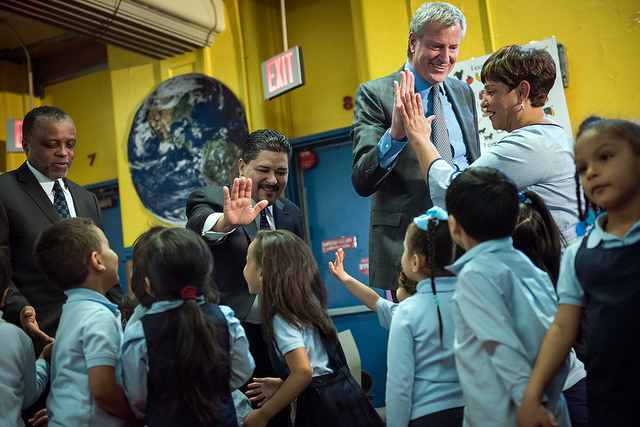
(Credit: Photographer/Mayoral Photography Office)
When I was in 5th grade at a public elementary school in Manhattan, my teacher was Mrs. Camiji, and I loved her. She taught us about diverse cultures all over the world, and pushed us to think about what roles we could serve in our community. It was empowering to see her in front of the classroom. She was the first African-American classroom teacher I ever had, and the last African-American classroom teacher I had until college.
Ms. Camiji was part of the reason I have been so committed to education as an adult. Over the past four years, I dedicated hundreds of hours serving on the city’s Panel for Educational Policy and voting on hundreds of policies affecting the students of color who make up the vast majority of the city’s public school students. But extremely few of those policies have directly addressed the racism and bias in our schools that are obstacles to academic achievement.
In his State of the City speech a few months ago, Mayor de Blasio said, “We face an achievement gap today that is rooted in the enslavement of Americans and the pervasive discrimination against people of color over centuries. We know exactly where the problem comes from, but to defeat structural racism and to overcome this achievement gap, we have to flip the script. We have to do something different when it comes to education….”
The mayor is right, and he is in a position to change this. Former schools Chancellor Carmen Farina made many positive changes in New York City public schools - elevating the role of educators, diminishing the role of standardized tests, expanding community schools, and other great initiatives. But over the past four years, this administration has danced around issues of systemic racism in schools, unwilling to confront it directly.
Despite a deep body of research showing that students are more likely to succeed academically when they see themselves reflected in the books and curriculum they read, in the courses they take, in the issues discussed in class, I have seen very few system-wide policies that reflect this approach to advancing the success of students of color, beyond small and excellent initiatives like NYCMenTeach and Expanded Success Initiative.
I hope that the new leader of the school system, Chancellor Richard Carranza, will take up this issue and do more than the administration has so far.
Chancellor Carranza has seen first-hand, as a principal and a superintendent, the incredible impact on students of color when they learn about their own history and culture, and from educators who understand and connect with their history and culture. He has a reputation for engaging families in genuine and culturally appropriate ways, and knows the investment in schools that approach builds.
My daughter graduated from high school last year, and she never had an African-American classroom teacher in New York City public schools. In elementary school there was one African-American music teacher; in high school there was an African-American substitute science teacher. The students loved that science teacher, and my daughter confided in him and relied on his input to shape her decisions and keep her focused. But it’s a disgrace that my daughter’s teachers were no more diverse than my own, 25 years earlier.
Mayor de Blasio and Chancellor Carranza, let’s make this the last generation of New York City public school students who have to experience what my daughter and I have. Let’s grow the number of teachers and administrators of color, increase cultural competency among all teachers, and diversify curriculum and course offerings. This is the path to expanding academic success among our students of color, and for all students.
***
Elzora Cleveland is a former mayoral appointee on the Panel for Educational Policy, and a parent leader with the NYC Coalition for Educational Justice. On Twitter @CEJNYC.
***
Have an op-ed idea or submission for Gotham Gazette? Email This email address is being protected from spambots. You need JavaScript enabled to view it.
